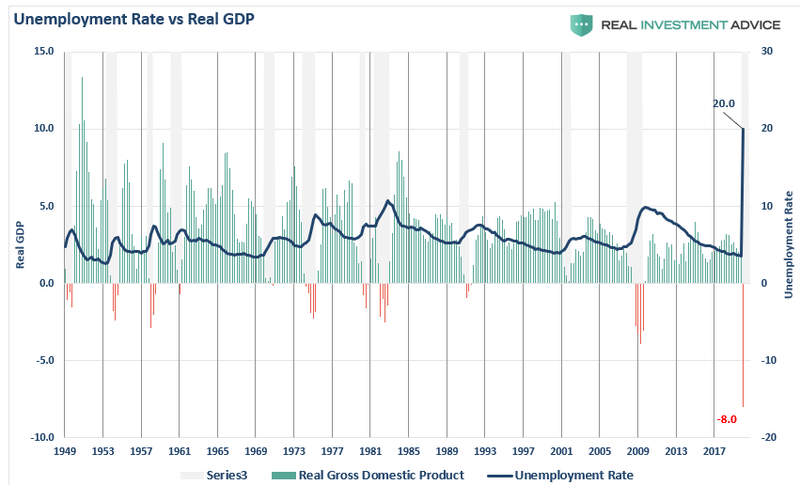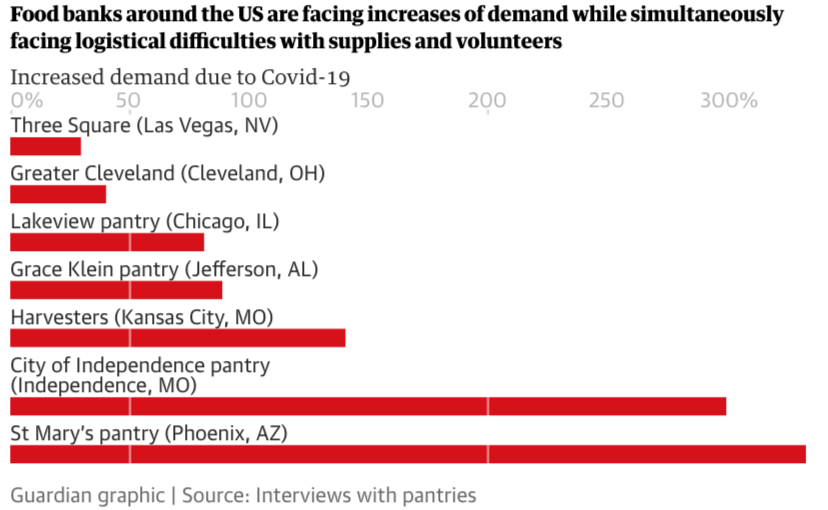Food Banks Overwhelmed As America’s “Working Poor” Starve During Lockdown
America is crashing into a depression. In just two weeks, 10 million people have claimed unemployment benefits. This has put unprecedented stress on food bank networks across the country, a new investigation via The Guardian shows.
The US labor market is in free fall – the increasing lockdowns across major US metropolitan areas have forced millions of people out of work and into a hunger crisis.
The Guardian shows demand for food aid in some regions of the country has surged eightfold in recent weeks as RealInvestmentAdvice.com’s Lance Roberts warns the unemployment rates in the US could spike to levels not seen since the “Great Depression,” or about 15-20% in the second quarter.
The National Guard has been deployed for a variety of reasons: One is to support local area hospital systems, another is to maintain social order, and now soldiers in Cleveland, Pittsburgh and Phoenix have supported food banks to ensure shortages do not materialize, mostly because that would trigger social unrest among the working poor.
“I’ve been in this business over 30 years, and nothing compares to what we’re seeing now. Not even when the steel mills closed down did we see increased demand like this,” said Sheila Christopher, director of Hunger-Free Pennsylvania, which represents 18 food banks across 67 counties.
The Guardian provides a snapshot of the unprecedented demand hitting food banks:
- In Amherst, home to the University of Massachusetts’ largest campus, the pantry distributed 849% more food in March compared with the previous year. The second-largest increase in western Massachusetts was 748% at the Pittsfield Salvation Army pantry.
- The Grace Klein community food pantry in Jefferson county, which has the largest number of confirmed Covid-19 cases in Alabama, provided 5,076 individuals with food boxes last week – a 90% increase on the previous week.
- In southern Arizona, demand has doubled, with pantries supplying groceries to 4,000 households every day – double the number supplied in March 2019. “We saw an increase during the federal government shutdown but nothing as rapid, massive or overwhelming as this,” said Michael McDonald, CEO of the Community Food Bank of South Arizona.
- A helpline set up by the Greater Pittsburgh community food bank has received more than a thousand calls in the past two weeks, 90% of which came from newly unemployed people. Here, pantries ordered 50% to 60% more food for March and April than usual.
- The Lakeview pantry in Chicago is on track to provide food for as many as 2,000 individuals this week – compared with 1,100 before the coronavirus crisis.
- The north Florida food bank, which relied heavily on contributions from retailers, has seen donations drop by 85% to 90% as shoppers bulk-buy, leaving shelves empty. But donations from restaurants, golf tournaments and even Disney World have increased, so the food bank is switching to ready meals, paying furloughed chefs to cook for thousands of senior citizens in housing facilities.
- In Las Vegas, the Three Square food bank has increased weekly food distribution by 30%, from 1m to 1.3m lbs of food. New drive-thru distribution centres have been set up across the valley as 170 of its 180 distribution outlets have been forced to temporarily close due to CDC social distancing guidelines. “Every line at every distribution centre exceeds the amount of food in our trucks,” said chief operating officer Larry Scott.
- The Kansas City-based Harvesters food bank, which serves 16 counties in north-east Kansas and 10 in north-west Missouri, sent out 12,000 boxes to pantries on Monday 23 March – a 140% rise on the 5,000 boxes typically ordered. “It was the largest distribution day in our 40-year history,” said its communications manager, Gene Hallinan.
Feeding America spokesperson Zuani Villarreal said the surge in job losses “is a perfect storm impacting food banks.”
The evolution of the virus crisis could be social destabilization across low-income areas of inner cities. As we’ve been warning for a while, many adults have no emergency savings and insurmountable debts. Most people don’t have enough funds to bridge their finances for three months, which brings us to our piece from last week that shows cars lined up to receive food from a food bank in Duquesne, Pennsylvania.
Hundreds of cars wait to receive food from the Greater Community Food Bank in Duquesne. Collection begins at noon. @PghFoodBank @PittsburghPG pic.twitter.com/94YFaO7dqX
— Andrew Rush (@andrewrush) March 30, 2020
“First, we saw people who lived paycheck to paycheck, got laid off and didn’t know where the next meal was coming from, followed by those who had a couple of weeks of savings. Now, people who knew about us because they donated or volunteered are coming in for food,” said Jerry Brown, media spokesman for St Mary’s Food Bank in Phoenix, Arizona. “The 2008 recession doesn’t touch this. It’s a different ballgame.”
So, what happens when tens of millions of jobless Americans become hangry? Is social unrest next?
Tyler Durden
Sun, 04/05/2020 – 21:45
via ZeroHedge News https://ift.tt/2Xa5flQ Tyler Durden

